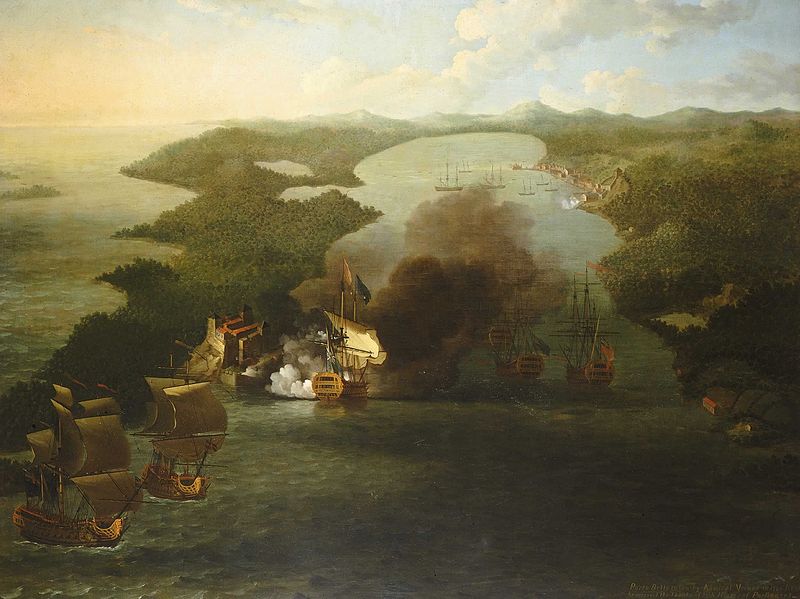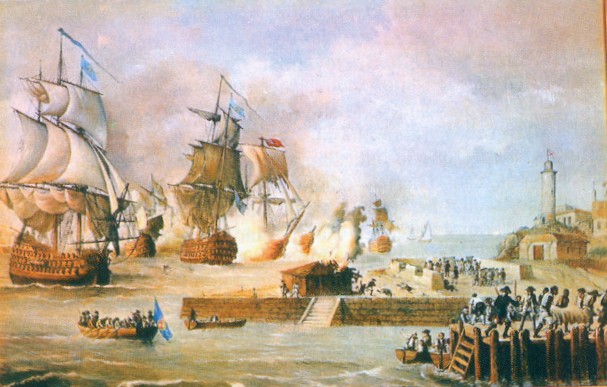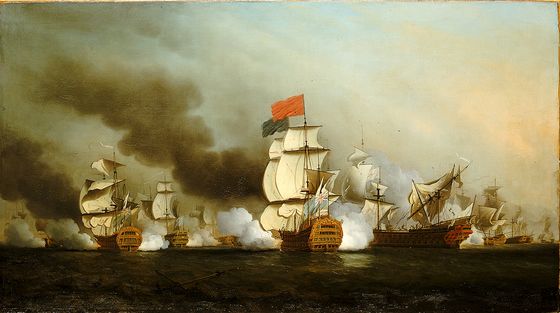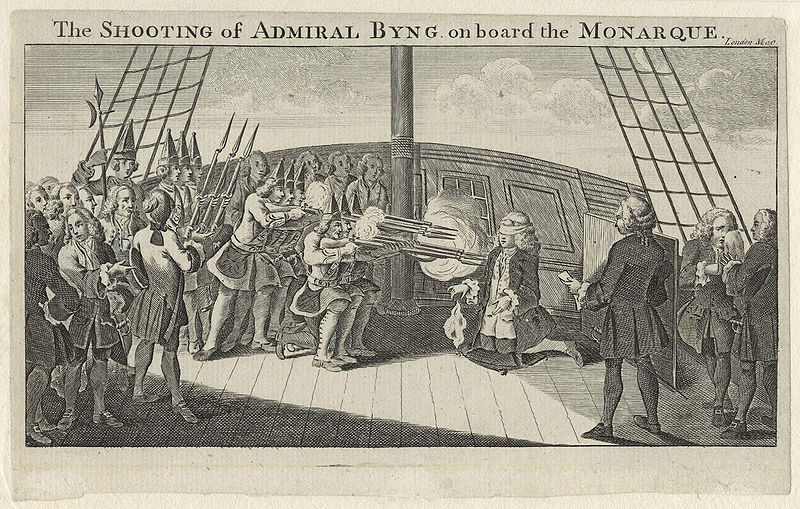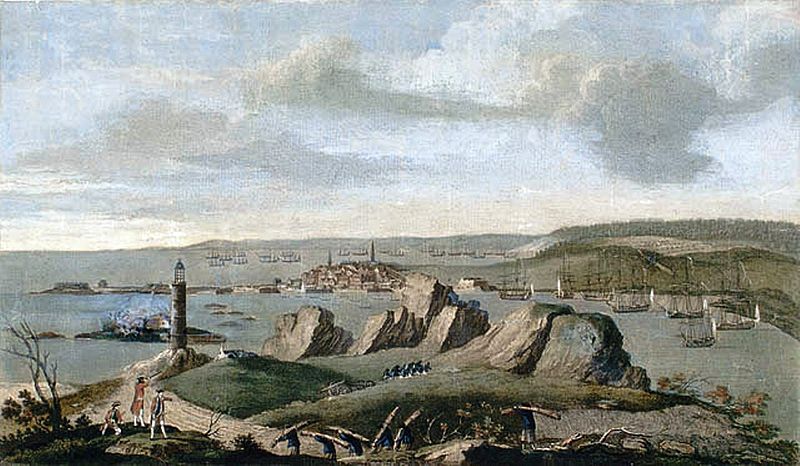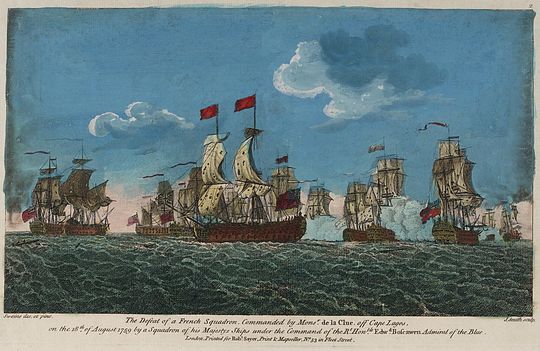<Back to Index>
- Engineer John Argyris, 1913
- Poet Íñigo López de Mendoza y de la Vega, 1st Marquis of Santillana, 1398
- Admiral of the Royal Navy Edward Boscawen, 1711
PAGE SPONSOR
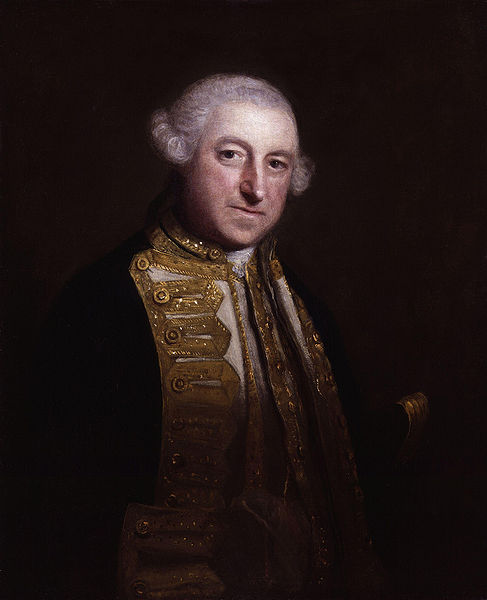
Admiral Edward Boscawen, PC (19 August 1711 – 10 January 1761) was an Admiral in the Royal Navy and Member of Parliament for the borough of Truro, Cornwall. He is known principally for his various naval commands throughout the 18th Century and the engagements that he won, including the Siege of Louisburg in 1758 and Battle of Lagos in 1759. He is also remembered as the officer who signed the warrant authorising the execution of Admiral John Byng after Byng's court martial in 1757 after the failure of Byng to engage the enemy at the Battle of Minorca.
In his political role, he served as a Member of Parliament for
Truro from 1742 until his death although due to his almost constant
naval employment he does not appear to have been particularly active in
the role. He also served as one of the Lords Commissioners of the Admiralty on the Board of Admiralty from 1751 and as a member of the Privy Council from 1758 until his death in 1761.
The Honourable Edward Boscawen was born in Tregothnan, Cornwall, England on 19 August 1711. Edward was the third son of Hugh Boscawen, 1st Viscount Falmouth and his wife Charlotte.
The young Edward joined the navy at the age of 12 aboard the HMS Superb of 60 guns. The Superb was sent to the West Indies with Admiral Francis Hosier. Boscawen stayed with Superb for three years during the Anglo - Spanish War. He was subsequently reassigned to the HMS Canterbury, HMS Hector, and HMS Namur under Admiral Sir Charles Wager and was aboard the Namur when she sailed into Cadiz and Livorno following the Treaty of Seville that ended hostilities between Britain and Spain. On 25 May 1732 Boscawen was promoted lieutenant and in the August of the same year rejoined his old ship the 44 gun fourth rate Hector in the Mediterranean. He remained with her until 16 October 1735 when he was promoted to the 70 gun HMS Grafton. On 12 March 1736 Boscawen was promoted by Admiral Sir John Norris to the temporary command of the 50 gun HMS Leopard. His promotion was confirmed by the Board of Admiralty. In June 1738 Boscawen was given command of HMS Shoreham a small sixth rateof 20 guns. He was ordered to accompany Admiral Edward Vernon to the West Indies in preparation for the oncoming war with Spain.
The War of Jenkins’ Ear proved to be Boscawen’s first opportunity for action and when the
Shoreham
was declared unfit for service he volunteered to accompany Vernon and the fleet sent to attack
Porto Bello.
In 1741 Boscawen was part of the fleet sent to attack another Caribbean port, Cartagena de Indias. Large reinforcements had been sent from Britain, including 8,000 soldiers who were landed to attack the chain of fortresses surrounding the Spanish colonial city. The Spanish had roughly 6,000 troops made up of regular soldiers, sailors and local loyalist natives. The siege lasted for over two months during which period the British troops suffered over 18,000 casualties, the vast majority from disease. Vernon’s fleet suffered from dysentery, scurvy, yellow fever and other illnesses that were widespread throughout the Caribbean during the period. As a result of the battle, Prime Minister Robert Walpole’s government collapsed and George II removed his promise of support to the Austrians if the Prussians advanced into Silesia. The defeat of Vernon was a contributing factor to the increased hostilities of the War of Austrian Succession. Boscawen had however distinguished himself once more. The land forces that he commanded had been instrumental in capturing Fort San Luis and Boca Chica Castle, and together with Knowles he destroyed the captured forts when the siege was abandoned. For his services he was promoted to command the 70 gun Prince Frederick to replace Lord Aubrey Beauclerk who had died during the siege.
In 1742 Boscawen returned in the Prince Frederick to England where she was paid off and Boscawen joined the Fleet commanded by Admiral Norris in the newly built 60 gun HMS Dreadnought. In the same year he was returned as a Member of Parliament for Truro, a position he held until his death.
In 1744 the French attempted an invasion of England and Boscawen was with the fleet under Admiral Norris when the French fleet were sighted. The French under Admiral Rocquefeuil retreated and the British attempts to engage were confounded by a violent storm that swept the English Channel. Whilst cruising the Channel, Boscawen had the good fortune to capture the French frigate Médée. She was the first capture of an enemy ship made during the War of Austrian Succession and was commanded by M. de Hocquart. The Médée was sold and became a successful privateer under her new name Boscawen commanded by George Walker.
At the end of 1744 Boscawen was given command of the HMS Royal Sovereign, guardship at the Nore anchorage. He commanded her until 1745 when he was appointed to another of his old ships HMS Namur that had been reduced (razéed) from 90 guns to 74 guns. He was appointed to command a small squadron under Vice - Admiral Martin in the Channel.
In 1747 Boscawen was ordered to join Admiral Anson and took an active part in the first Battle of Cape Finisterre. The British fleet sighted the French fleet on 3 May. The French fleet under Admiral de la Jonquière was
convoying its merchant fleet to France and the British attacked. The
French fleet was almost completely annihilated with all but two of the
escorts taken and six merchantmen. Boscawen was injured in the shoulder during the battle by a musket ball. Once more the French captain, M. de Hocquart became Boscawen’s prisoner and was taken to England.
Boscawen was promoted rear - admiral of the blue on July 15, 1747 and was appointed to command a joint operation being sent to the East Indies. With his flag in the Namur and five other line of battle ships a few smaller men of war and a number of transports Boscawen sailed from England on November 4, 1747. On the outward voyage Boscawen made an abortive attempt to capture Mauritius by surprise but was driven off by French forces. Boscawen continued on arriving at Fort St. David near the town of Cuddalore on 29 July 1748 and took over command from Admiral Griffin. Boscawen had been ordered to capture and destroy the main French settlement in India at Pondicherry. Factors such as Boscawen’s lack of knowledge and experience of land offensives, the failings of the engineers and artillery officers under his command, a lack of secrecy surrounding the operation and the skill of the French governor Joseph François Dupleix combined to thwarrt the attack. The British forces amounting to some 5,000 men captured and destroyed the outlying fort of Aranciopang. This capture was the only success of the operation and after failing to breach the walls of the city the British forces withdrew. Amongst the combatants were a young ensign Robert Clive, later known as Clive of India and Major Stringer Lawrence, later Commander - in - Chief, India. Lawrence was captured by the French during the retreat and exchanged after the news of the Treaty of Aix - la - Chapelle had reached India. Over the monsoon season Boscawen remained at Fort St David. Fortunately, for the Admiral and his staff, when a storm hit the British outpost Boscawen was ashore but his flagship the Namur went down with over 600 men aboard.
Boscawen returned to England in 1750. In 1751 Anson became First Lord of the Admiralty and asked Boscawen to serve on the Admiralty Board. Boscawen remained one of the Lord Commissioners of the Admiralty until his death.
On 4 February 1755 Boscawen was promoted vice - admiral and given command of a squadron on the North American Station. Despite the fact that Britain and France were not formally at war, preparations were being made for a conflict by then considered inevitable. A squadron of partially disarmed French ships of the line were dispatched to Canada loaded with reinforcements and Boscawen was ordered to intercept them. The French ambassador to London, the Duc de Mirepoix had informed the government of George II that any act of hostility taken by British ships would be considered an act of war. Thick fog both obstructed Boscawen's reconnaissance and scattered the French ships, but on 8 June Boscawen’s fleet sighted the Alcide, Lys and Dauphin Royal off Cape Ray off Newfoundland. In the ensuing engagement the British captured the Alcide and Lys but the Dauphin Royal escaped into the fog. Amongst the 1,500 men made prisoner was the captain of the Alcide. For M. de Hocquart it was the third time that Boscawen had fought him and taken his ship. Pay amounting to £80,000 was captured aboard the Lys. Boscawen, as admiral of the fleet, would have been entitled to a sizeable share in the prize money. The British fleet headed for Halifax to regroup but a fever spread through the ships and the Admiral was forced to return to England. The fever killed almost 2,000 of his men.
Boscawen returned to the Channel Fleet and was commander - in - chief Portsmouth during the trial of Admiral John Byng. Boscawen signed the order of execution after the King had refused to grant the unfortunate admiral a pardon.
In October 1757 Boscawen was second in command
under Admiral
Edward Hawke. On 7 February 1758 Boscawen was promoted to Admiral of
the blue squadron and ordered to take a fleet to North America. Once
there, he took naval command at the Siege of Louisburg during June and July of 1758. On this occasion rather than entrust the land assault to a naval commander, the army was placed under the command of General Jeffrey Amherst and General James Wolfe. The Siege of Louisburg was one of the key contributors to the capture of French possessions in Canada. Wolfe used Louisburg as a staging point for the Siege of Quebec and
the capture of the town took away from the French the only effective
naval base that they had in Canada, as well as leading to the
desrtuction of four of their ships of the line and the capture of
another. On his return from North America Boscawen was awarded the Thanks of both Houses of Parliament for his service. The King made Boscawen a Privy Counsellor in recognition for his continued service both as a member of the Board of Admiralty and commander - in - chief.
In April 1759 Boscawen took command of a fleet bound for the Mediterranean. His aim was to prevent another planned invasion of Britain by the French. With his flag aboard the newly constructed HMS Namur of 90 guns he blockaded Toulon and kept the fleet of Admiral de le Clue - Sabran in port. In order to tempt the French out of port, Boscawen sent three of his ships to bombard the port. The guns of the batteries surrounding the town drove off the British ships. Having sustained damage in the action and due to the constant weathering of ships on blockade duty Boscawen took his fleet to Gibraltar to refit and resupply. On 17 August a frigate that had been ordered to watch the Straits of Gibraltar signalled that the French fleet were in sight. Boscawen took his available ships to sea to engage de la Clue. During the night the British chased the French fleet and five of de la Clue’s ships managed to separate from the fleet and escape. The others were driven in to a bay near Lagos, Portugal. The British overhauled the remaining seven ships of the French fleet and engaged. The French line of battle ship Centaur began a duel with the Namur but was outgunned and struck her colours. The damage aboard the Namur forced Boscawen to shift his flag to the HMS Newark of 80 guns. Whilst transferring between ships, the small boat that Boscawen was in was hit by an enemy cannon ball. Boscawen took off his wig and plugged the hole. Two more French ships, the Souverain and Guerrier escaped during the second night and on the morning of the 19 August the British captured the Téméraire and Modeste and drove the French flagship Océan and Redoubtable ashore where they foundered and were set on fire by their crews to stop the British from taking them off and repairing them. The five French ships that avoided the battle made their way to Cadiz where Boscawen ordered Admiral Broderick to blockade the port. There was a certain controversy surrounding the battle in that the British pursued the French into the waters of a neutral country and there engaged the fleet. It is possible that this controversy prevented Boscawen from receiving as much recognition as other admiral’s have received for lesser victories.
Boscawen returned to England where he was promoted General of Marines in recognition of his service. He was given the Freedom of the City of Edinburgh. Admiral Boscawen returned to sea for the final time and took his station off the west coast of France around Quiberon Bay. After a violent attack of what was later diagnosed as Typhoid fever the Admiral came ashore where, on 10 January 1761, he died at his home in Hatchlands Park in Surrey. His body was taken to St. Michael’s Church, Penkivel, Cornwall where he was buried. The monument at the church begins:
Here lies the Right Honourable
Edward Boscawen,
Admiral of the Blue, General of Marines,
Lord of the Admiralty, and one of his
Majesty's most Honourable Privy Council.
His birth, though noble,
His titles, though illustrious,
Were but incidental additions to his greatness.
In 1742 Boscawen married Frances Glanville with whom he had three sons and two daughters. The youngest son,
George succeeded his uncle as third Viscount Falmouth.
